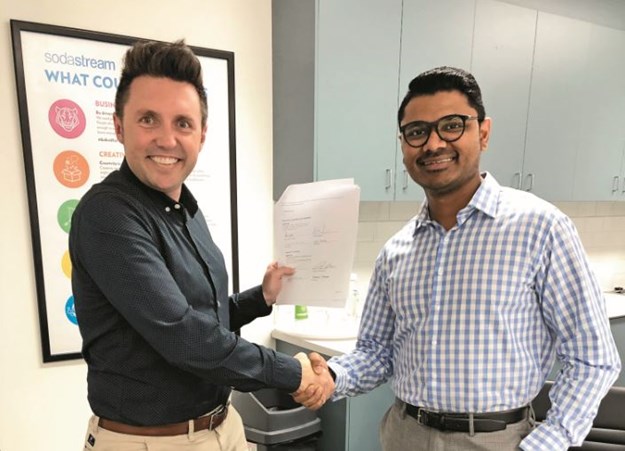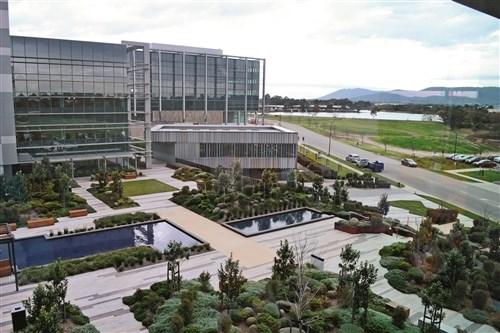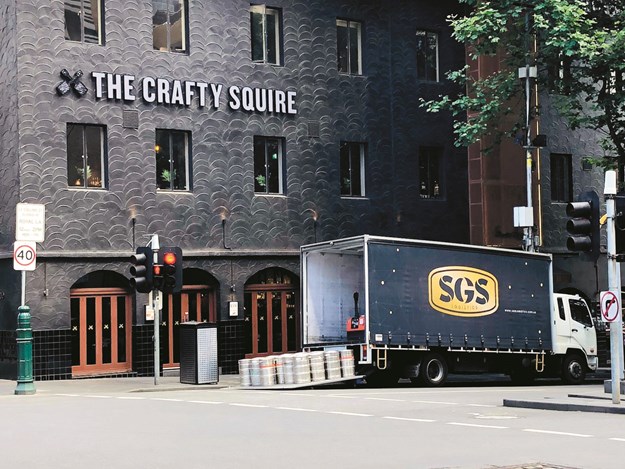How SGS Logistics is breaking new ground with some timeless values
SGS Logistics is a relatively new kid on the block but its approach reveals a maturity beyond its years.
In its fourth year, the business led by Luke Sadler and David Gay may seem like any other operation, yet dig deeper and subtle differences are reaping the rewards.
So much so that SGS most recently featured in the Financial Review’s 2018 Fast Starters – one of only two transport companies – as an upstart enjoying a solid rise.
Noticeably, there’s a progressive edge to the operation.
Located in a swanky Scoresby business park that looks more like a Silicon Valley hot-desking utopia than a standard transport outfit, the directors are personable and savvy digital operators who make use of their LinkedIn networks and emotional intelligence to help drive the business forward.
They don’t consider themselves disruptors, either, saying their philosophy is quite unassuming.
BREAD AND BUTTER
Currently, SGS’s fleet of 120 belongs entirely to its sub-contractors. From the outset, though, Sadler and Gay are adamant the key to their early success has been paying those drivers well.
“We were of the view that with owner-drivers there was this cycle of getting salespeople to put together great solutions,” Sadler says. “It would then lead to being tight on resources to make sure margins were being delivered.
“That would often lead to drivers getting paid barely enough or less than they deserved.”
While that may deliver the short-term gross margins companies seek, the long-term impacts may be detrimental, Gay adds.
“Because they’re getting poorly paid, drivers are on the lookout for something else.
“Productivity for the customer is down too, because the drivers try find any way they can within the contract to get remunerated. Driver turnover leads to inexperienced drivers, possibly leading to poor product handling and relationships.
“Money is then spent on recruiting and retraining again, and potentially not being able to keep a contract.”
The directors believe foregoing margins – they aim for 5 to 10 per cent pay above market rates – goes a long way to abating such issues.
“We quite proudly promote what the rate of pay is because we know it’s better than most other places.
“If that can have better outcomes for the driver and customer, we’re more likely to keep the work.
“The lower gross margin strategy by paying the drivers more should lead to a higher net profit, because it makes it easier to grow as we keep our customers.”
HOW IT STARTED
Applying that philosophy, SGS has come a long way in short time.
Like others before them on these pages, both earned their stripes at Kings Transport. But turning a new leaf can be daunting, Sadler says.
“Day one, we did look at each other and go, ‘What now?’
“The beginning was getting everything set up and reaching out to our networks and hoping some would support us,” Gay says.
In hindsight, that clean slate gave Sadler and Gay a chance to get the safety and operational infrastructure right to be equipped for customer procurement and service.
“We had all the backend done before our first customer started, rather than the other way around.
“I think we’d worked so hard in transport previously, we probably thought it was going to be harder without realising we’d actually done most of the hard yards – and our relationships responded far more positively than we expected.”
Once SGS got to prove its business model, the approval started to grow.
“I’ll give a shout out to SodaStream. They were our first large customer, they took the leap of faith, and the partnership grew from one vehicle to 18,” Sadler says.
SodaStream wasn’t an existing relationship but has flourished to the point where it now advocates for SGS in testimonials.
 |
|
Sadler with Naveen Maram, Sodastream Australia’s national operations manager
|
“Once we had those proof points, it made it easier for those existing relationships and introductions,” Sadler says. “We promoted those on LinkedIn and the networks we built over the journey came to us rather than us chasing them.”
There was no particular industry SGS targeted in its formative years, so long as a client needed a driver on a permanent basis, and the job did not require a specialised vehicle.
SGS doesn’t rule out investing in its own fleet in for future specialised logistics roles – but not yet.
“The more assets you’ve got locked in, the harder it is to turn. Being a young business you need to change quickly where required.
“There’s also particular personnel you need for that, and we need to be at a point where we can sleep at night knowing a missed assumption or a client going under doesn’t put the whole business at risk.
“So a contract-based model at this point gives us that flexibility.”
PRESENTATION IMPORTANCE
Both also acknowledge that, on the flip side, the sub-contractor model can translate to a potential reputational risk.
“And yet the niche we were looking to build really did suit customer-focused interaction,” Gay says.
“One of the things we do once we select a suitable driver is send them out to meet with a client. That way they can see the site and product, and ask any questions to make sure there are no surprises when things start.”
That’s where driver selection starts to add value to the client, Sadler says.
“When you’re in more of a DC [distribution centre] to DC scenario it’s more nameless and faceless, and people look at the cost side of things if they don’t see the human value.
“Often the presentation of the driver, the communication skills, just don’t matter as much as: is your vehicle suitable?
“Whereas for us, the value of the human quality comes to the fore.
“The big picture is: if you get these guys on board and make them feel part of something, in return they’ll do more for you.”
To ensure the best quality driver, both say they interview and recruit candidates the same way they would “for a white collar position”.
“It’s not just: ‘Okay, how long have you been a driver for? Can you show me your licence?’
“We’re interested in the person – not whether they have the experience, but what was their experience.
“Honestly, our driver recruitment is a pain in the arse because it’s so thorough. But because the customer then gets the service and productivity outcomes, it reduces turnover and we then spend less time on recruitment.”
Like with any job interview, that doesn’t mean SGS gets it 100 per cent right: “But, if you do it properly, it makes it far more likely.”
For all the talk of driver shortages, perhaps unsurprisingly, they say they haven’t had issues attracting talent.
VEHICLES
Today, SGS’s drivers operate anything from one-tonne vans up to 14-tonne tautliners, including pantechs, refrigerated vehicles and tailgates. The assets might not be on the company books but Sadler and Gay still see them under their control and treat them accordingly.
“If a vehicle looks like it’s on its last legs and terribly represents us and our customers then we’re not interested,” Gay explains.
“But some people have different standards and are quite happy for a 20-year-old well-presented vehicle that has been properly serviced and maintained. Other customers want something that is near new.
“We get that information up front and recruit accordingly.
“We have comprehensive COR services in place and with duty of care we ensure the quality and the servicing of those vehicles – so we get pre-start checks, service records, dates of next service due, etc.”
To date SGS hasn’t had to face serious challenges or incidents from a compliance perspective.
“We’re fully supportive of the changes to COR legislation,” Sadler says. “A lot of time and effort goes into meeting legislative obligations – not just so we are law-abiding business owners, but because it’s important to us that we’re doing our part to make the industry safer.”
THE FUTURE
SGS started in Melbourne with naught but now has 120 permanent drivers, seven backroom staff, and a new office in Sydney.
It moves everything from retail, fast-moving consumer goods, beverages, fashion accessories, steel, and waste. About 95 per cent of its work is metropolitan, in locations like Brisbane, Adelaide, Perth, Canberra, Wollongong, Central Coast, the Gold Coast and Toowoomba.
“We’ve got a long level of coverage up the eastern seaboard and we certainly classify ourselves as a national business,” Gay says.
He says starting year three they had an aim of $2.6 million turnover. The result was over $7 million, and after their third full year that became $10 million.
“We’re competitors and we want to keep growing but we don’t have a specific target. We’re more about just having a great next year.”
Importantly, that doesn’t come at the cost of personal values, which both agree have often been forgotten in the pursuit of margin increases or margin protection.
Part of making their drivers feel part of a team includes initiatives like barbecues and Christmas hampers – and every SodaStream driver gets a retail pack.
“Still now with our newer drivers, we get emotional phone calls saying they can’t believe they got something.
“I think it reflects poorly on industry that we get that sort of response.
“We feel like what we’re paying drivers still isn’t enough. But we’re not going to win work if we do that.
“Our long-term vision is to grow to a size that we can start to influence the market to get drivers paid a level they used to get a long time ago.”
That vision is in its early days but is one that’s hard to disagree with.
DRIVER SATISFACTION
Washington Kudiwa (above) can attest to SGS’s philosophy. A former lawyer in his native Zimbabwe, Kudiwa’s journey has taken him to Australia via the UK.
Starting out for a more mainstream company, he saw an ad for SGS in early 2016 and took the plunge, and has enjoyed his time ever since.
“The bigger companies look after their own – the environment was getting a bit hostile and there was so much pressure on the driver.
“By the time you get home, you’re an angry man.
“Here, I don’t feel that pressure.
“They respect you as a human being. They’re approachable.
“I know I have a job to do and ensure the customer is happy. But If I have any personal requirements I don’t need to explain myself.
“Even though I’m a contractor it’s like a family – I feel a part of the company.”






